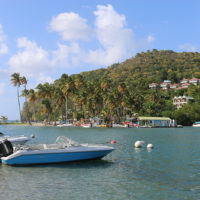Go to Cart 0,00 €
0
Saint Lucia
General Information
Things to do
St. Lucia is waiting for you with some of the most romantic views with many picturesque places to be discovered. This beautiful island is an adventure seeker paradise from under water shipwreck dives to the eco-tours through its tropical rainforest. St Lucia offers many hiking adventures around the Pitons (Gros and Petit Piton). Even if you are an experienced hiker a guided tour is always recommended.
St. Lucia has a mix of stunning golden and black sandy beaches with clear waters and a rich marine life. For beautiful sunsets consider a sunset sail. We included details on recommendations and tour operators in our guides.
Besides the traditional festivals “La Magwit” and “La Woz” St. Lucia is also well known for one of the top Jazz Festival worldwide with a mix of popular Caribbean and International artist. Trinidad and Tobago’s Machel Montano, Jamaica’s Shaggy as well as US artists such as Diana Ross, John Legend and Michael Bolton are popular names on previous line ups.
After taking in the beautiful sounds at the Jazz Festival you can relax at one of the island’s many boutique hotels. In St. Lucia you can experience everything from a top luxury hotel to the quaint and simple bed and breakfast leaving you with the energy and true beauty of this Caribbean island.
Make sure you don’t miss out on St. Lucia’s vibrant nightlife. The Rodney Bay area hosts great restaurants, cafés and shops which offer late night dining and dancing.
Cricket is the #1 sport of the island due to its colonial heritage. The annual Barbados Gold Cup in Sandy Lane attracts many spectators as one of the Caribbean’s best known horse race. The center for nightlife is on the West coast. A variety of bars, clubs, and restaurants can be found at the St. Lawrence Gap or “The Gap”. If you like to mingle with locals Baxter’s Road is a good recommendation for a night out.
Transportation to and on the island
Getting to St. Lucia is quite easy. The major airlines offer direct flights from North America, Canada and Europe. Jet Blue has a direct service to Castries from New York JFK while American Airlines flies from Miami among others. British Airways and Virgin Atlantic offer direct flights from London almost daily during peak season.
Also, many cruise liners from have St. Lucia scheduled as a destination and regional ferries operate a scheduled service between some of the Caribbean islands.
Once on the island the most commonly used forms of transportation are car rentals, taxis or buses (mini-vans). Whilst the mini-van is an inexpensive and great way to get to know the people in their environment the services is not scheduled.
Climate
The climate of St. Lucia is Tropical in nature and due to constant trade winds temperature remains pleasant, ranging from 21°C (70°F) to 32°C (90°F). St. Lucia like many of the other Caribbean countries experiences only two seasons, a wet season and a dry season. The dry season generally starts in December and extends through May while the wet season last from June to November. St. Lucia technically lies in the hurricane belt. The likelihood of an occurrence is relatively low though due to the South Eastern location of the island.
People and Culture
St. Lucia’s culture is strongly influenced by French music and arts, but also language. Patois is widely spoken besides the official language English and is an important part of St. Lucia’s culture. African and British influence is also strong on the island which makes it a very diverse place. The island’s outstanding cuisine is widely known for its flavors of tropical fruit, but also excellent seafood and Creole style stews. Make sure to try the national dish “Callaloo” which is a soup made from a spinach-like vegetable.
Besides great food and music St. Lucia has two Nobel Prize winners with Sir W. Arthur Lewis for economics in 1979 and Derek Walcott (literature) in 1992.
In today’s economy tourism plays the dominant role for St. Lucia although manufacturing and agriculture – primarily banana production – remain important factors.
History
Prior to the arrival of European colonists the island of St. Lucia was first inhabited by Arawaks and Caribs. In the year 1674 French colonists were able to gain control of the island, but between the 17th and the 19th century political control of the island changed hands between the French and the British Empire 14 times.
In 1803 British colonists were finally able to gain full control of the island and also reestablished slave trade which was finally abolished again in 1807. To this day the island of St. Lucia has a very strong French influence. This can be seen in its architecture, cuisine and music.
Geography & Geology
St. Lucia is the second largest island in the Windward Islands. The island is volcanic in nature and it is considered to be the most mountainous of the Caribbean Islands. In the southwest of the island the Gros Piton and the Petit Piton are the two characterizing peaks abruptly jotting out of the sea. Whilst they are not the highest mountains in St. Lucia the Pitons offer a challenging hike with rewarding stunning views over the island and the ocean.





